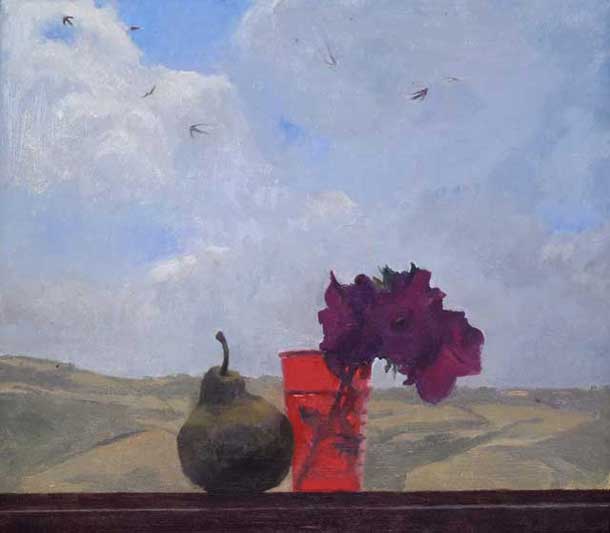
Lucy Barber Red Cup And Swallows oil on linen, 14 x 16 inches
click here for a larger view
Lucy Barber is an incredible painter whose landscapes and still-lifes has long enchanted me and who I made one of my earliest blog posts about. I’ve returned to her work for a closer view and she graciously agreed to an interview via email. Lucy Barber has shown extensively in a variety of venues including Denise Bibro Gallery, First Street Gallery, and the Lori Bookstein Gallery in NYC and has shown with the still life group, Zeuxis including their shows; The Common Object and Outside the Box: Zeuxis Paints the Landscape. Delaware College of Art & Design, in 2008. She studied at Brooklyn College’s M.F.A program with Lennart Anderson 1989, among other awards she received a Pollock-Krasner Foundation grant in 2001 and 1994.
Larry Groff: What lead you to decide to be a painter?
Lucy Barber: Well, it wasn’t a direct route and the path to it was filled with huge influences. First, I went to Pratt Institute to study photography, because after a class in high school I was crazy about isolating the “world” through the frame of the viewfinder. I loved how photography was fast and fresh! It taught me a lot about finding the “big composition” first. I also discovered more about designo, and developed a better eye for it, through the image-editing process (the old fashioned way on the contact sheet!). Philip Perkis was a very influential teacher then. Sensitivity to light (has always) inspired me and most times pulled me towards a subject.
I remember while still a photographer I saw a show at the Modern called something like “Painting after Photography,” a very interesting show. It changed my understanding of an artist like Degas for example, who used photography, and how it influenced the design of his compositions. In addition, two influential photographers at that time were Eugene Atget and Andre Kertesz.
After 10 years or so of doing photography I felt like something was missing in the creative process, so I explored a little. I took a class in graphic design (before InDesign or Illustrator…yikes!), and that didn’t do it. I took several classes in textile design at FIT, for printed and woven fabric design. It was interesting but didn’t get me fired up. Shortly after the classes at FIT, where I used color (gouache) for the designs, I thought I’d try painting. I talked with a neighbor in Brooklyn at the time, asking her about starting to paint and she agreed to give me a few private lessons. After a few sessions she recommended I take classes with Lennart Anderson, who at the time was teaching at Brooklyn College. I took the still life class he taught to the undergraduates and then took the Saturday morning figure painting class for the graduate students.
Something clearly “woke up” during this time, and it was because of color and the stuff of oil paint. I was reeling from learning to see all over again! I decided this was for me, then applied and got into the graduate painting program at Brooklyn College.
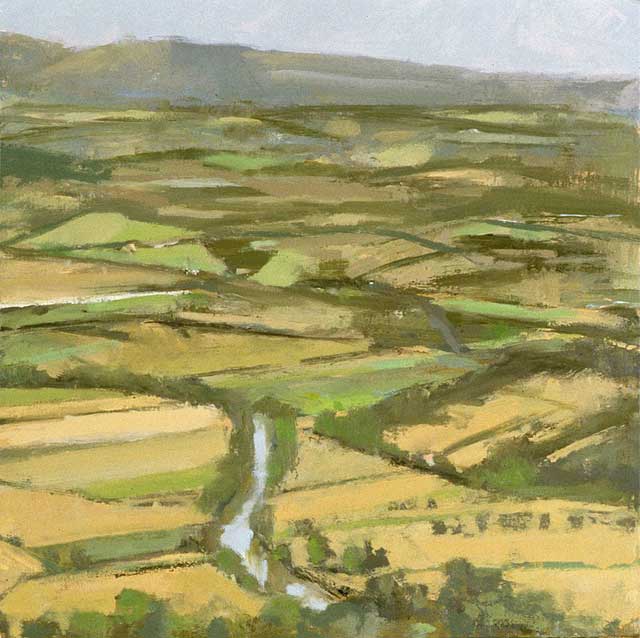
Tiber River No 1 oil on muslin on panel, 12 x 12 inches
Please Click for a Larger View (true with all of the images)

View From The Beehives oil on muslin on panel, 8 x 28 inches
LG: You studied with Lennart Anderson at Brooklyn College where many of his students went on to be insanely great painters and colorists. What can you remember about his teachings on color and painting that was most influential for you?
LB: The still life class was my first real painting class ever, with a teacher who was hugely interested in seeing well with humility and honesty. What I loved most about Lennart’s teaching was that he kept it simple, and it was immensely elegant…though I would have never put it that way before. The moments where I grasped how to see and how to paint with depth came from that simplicity. Simple does not mean easy. For example, Lennart would always talk about seeing the similarities and the differences. This is so basic but I struggled with it. I remember “dumbly” asking him several times about it and when I finally got it, it was so huge. The sum of taking this class was I learned how to “see” again and again for the first time.
Lennart brought in books regularly and read from them to the class, one in particular was about Ingres. He must have recommended Hawthorne On Painting, because I was reading it at the time, and I was always thinking abstractly about seeing those spots of color. Occasionally Lennart would work on student’s paintings. This is a pretty standard thing to do in the studio class and it’s immensely helpful, and Lennart once worked on a still life of mine. He took from a pale violet I had mixed up on the palette and put some of it into the shadow of a bunch of scallions. If you’re a student and recognize what is happening in the painting when a teacher does this, it’s pretty amazing. It took the painting up a notch or two and taught me a lot about how to bring light into a shadow. It’s a simple painting of a bunch of scallions, a lemon, a small white milk pitcher, all resting on a plain striped kitchen towel. It still hangs in my kitchen!
One day something out the window caught Lennart’s eye, which he brought to our attention, and as we looked out he described what he was looking at. He made this seem so important, it opened the eyes. I think the best teachers do that kind of thing, and I am fortunate enough to have studied under a teacher with the stature of someone like Lennart Anderson. The energy in the studio is on fire, you want to catch it and keep it, and you absorb though osmosis and teacher’s intent, to paint as though your life depended on it!
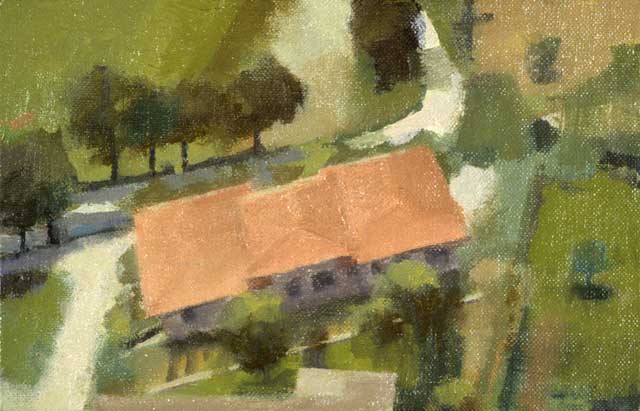
Roofs And Turning Road oil on linen on panel, 5 1/2 x 8 1/2 inches

Fore River Looking West oil on linen on panel, 8 x 28 inches
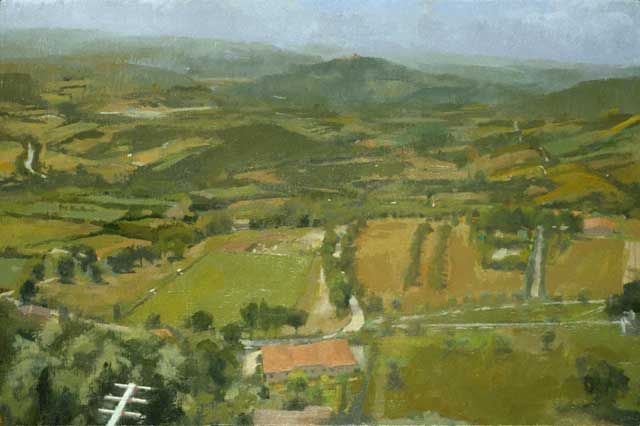
View With Antenna oil on linen on panel, 16 x 24 inches
LG: How important is the process of painting from observation to your work?
LB: It’s very important, and for me having an anchor in realism is key. Though as we know, the painting process itself is abstract. “Painting from observation” is an odd phrase, I think. It doesn’t mean I paint solely from what is exactly before me (whether the 3-dimensional world and/or a photograph), because that is impossible. The experience of light, place and color (and memory and imagination and all the senses) in each instance, exerts a huge ambient force. My job is to be aware of these things and to let them help me when I paint. The outside world is filled with endless supply for the senses. In the beginning I worked all the time from observation, because at the time even though I didn’t know it, I was collecting experiences of seeing (and sensing everything) and storing them in my brain. Then after a while I started doing whatever I had to do to make the painting work: start from observation, use photographs, invent what I had to, move things around compositionally…etc.
I am mostly mesmerized by the creative process, “seeing” and the awareness of seeing.
LG: Can you tell us how you go about making a painting? Do you make studies first or work out a careful drawing before you paint or do you just jump right in and work it all out as you go?
LB: It’s pretty simple, I usually do a bit of light sketching, I move around a lot looking at objects and space in different ways, or I move things (objects). I take photographs for reference after I’ve started a painting, or at the start. I’ll move elements around in a composition. If the motif in front of me is very strong and I’m happy with it, I’ll leave the composition as it is, but there is always some form of translation occurring.
LG: What colors do you put out on your palette?
LB: My first palette consisted of, going around from the bottom left of the palette and moving along the outer edge to the top right or middle of the right edge: titanium white, zinc yellow, cadmium yellow light, naples yellow, yellow ochre, alizarin crimson, cadmium red light, venetian red, ultramarine blue, cobalt blue, cerulean blue, virdian green, chromium oxide green, ivory black, burnt sienna, raw umber.
My palette today is a temperature palette with warm and cool colors for each hue, moving around from the bottom left of the palette to the top right with white at the left and start with yellows to reds to blues, neutral violet, to greens, then umber and black. I love using the warms and cools of each color.
Early on when I was fixed on paintings that were predominantly red I used a whole lot of reds and limited my palette. The same is true for the color yellow when I painted the still life paintings from the kitchen shelf series. It’s really exciting what opens up when one color predominates, and you have to find a way to find light and dark with the color without losing it’s light.
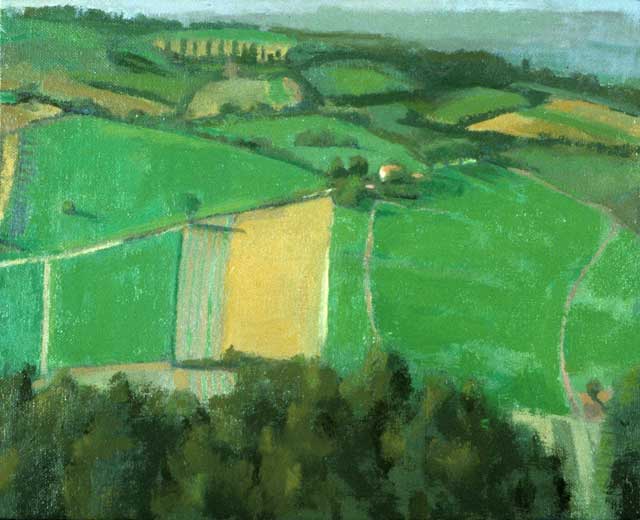
View No 1 With Green oil on linen on panel, 8 x 10 inches
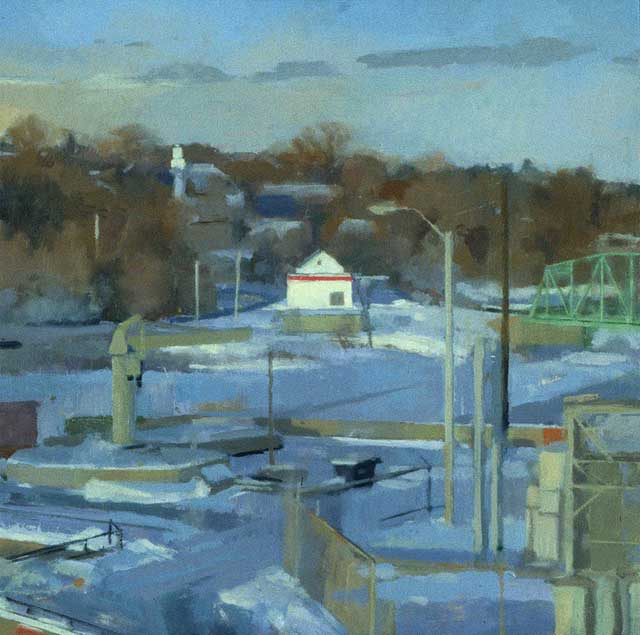
Androscoggin Winter, oil on panel, 18 x 18 inches
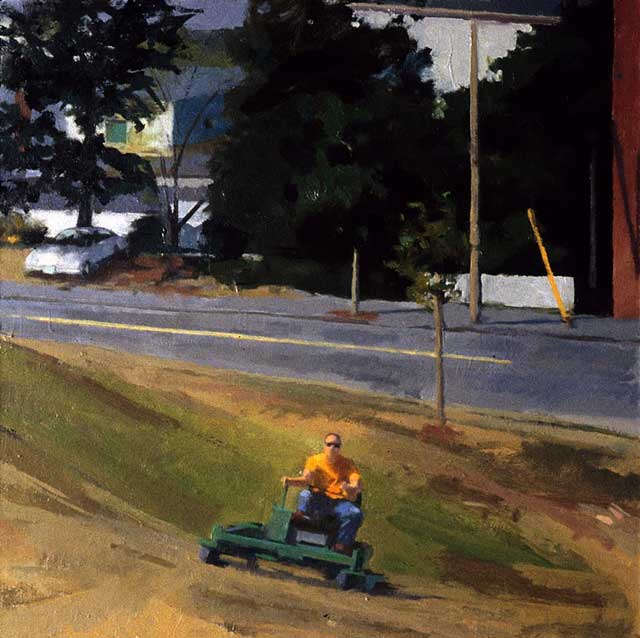
Lawnmower, oil on panel, 18 x 18 inches
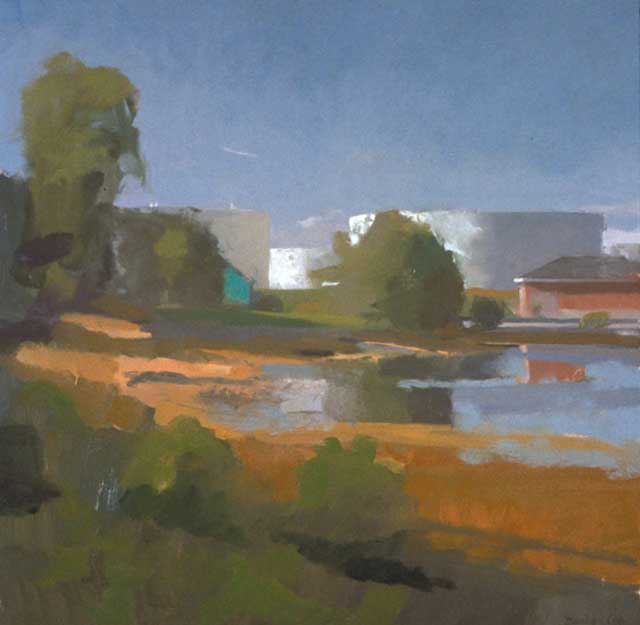
White Tanks, oil on paper, 18 x 18 inches
LG: What book has been significantly influential to your growth as a painter? What art book do you look at most often?
LB: When I started painting I spent a lot of time reading Hawthorne on Painting (the students notes), because it was so simple, true and clear. It really helped me when I took the still life class with Lennart Anderson. Earlier I spent a lot of time looking at Morandi, Chardin, Cezanne and others. I’ve looked at so many artists! Honestly right now there’s not just one book that I look at most often. One of my top three reads is Annie Dillard’s, Pilgrim at Tinker Creek which I absolutely loved. The chapter called “seeing” is amazing and she completely got it for me.
LG: What sustains or inspires you during moments when things get tough in the studio or art world?
LB: Nature sustains and inspires me. During tough passages I take a break and do something different to take my mind off it: look at another painting, start something new, call a friend, read poetry, pray or meditate, go for a walk. Once my mind is clear and fresh I can approach it again.
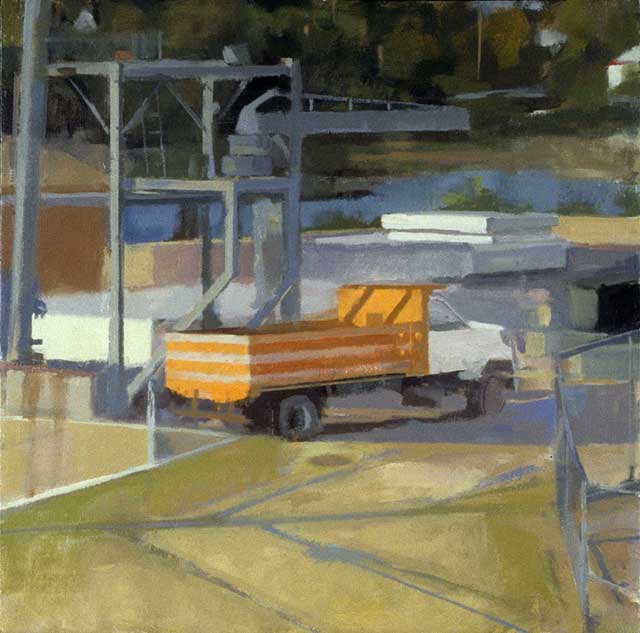
Orange Truck, oil on muslin on panel, 18 x 18 inches
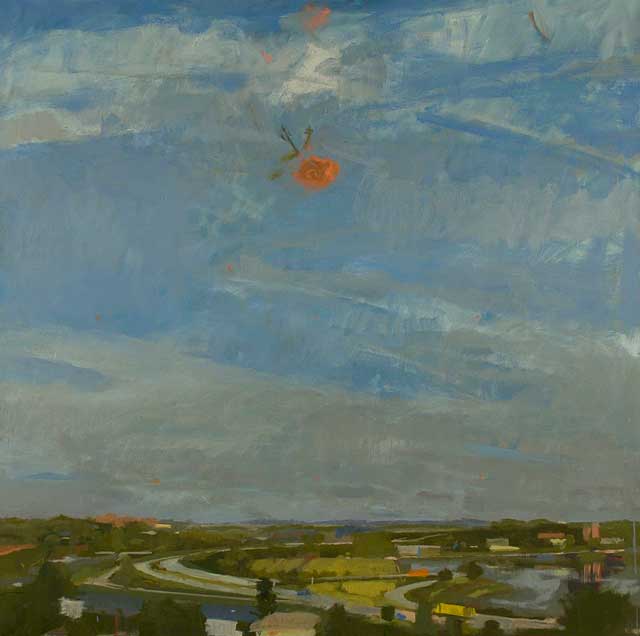
Rose Over Portland oil on canvas, 48 x 48 inches
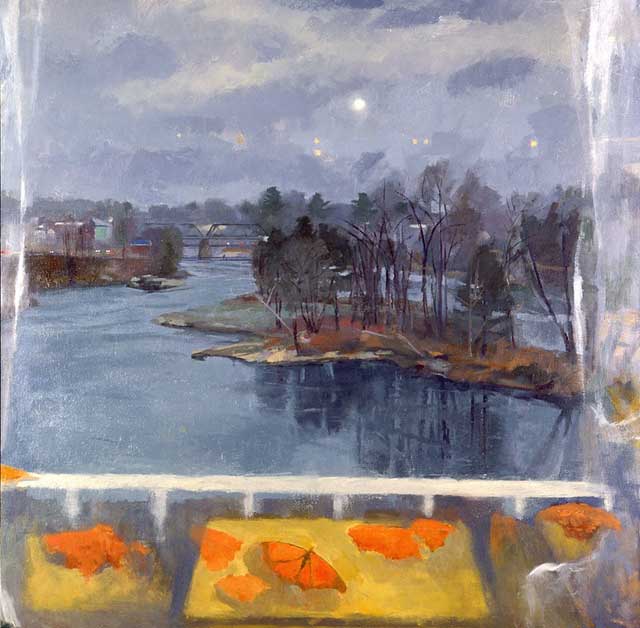
Metamorphosis oil on linen, 36 x 36 inches
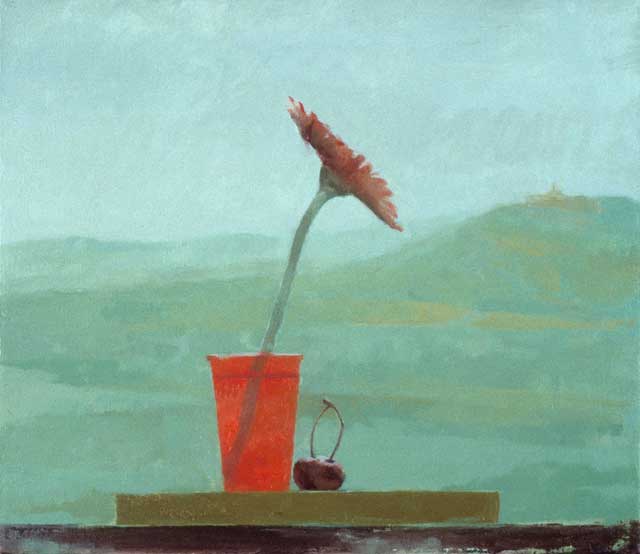
Red Gerbera And Cherries, oil on linen, 14 x 16 inches

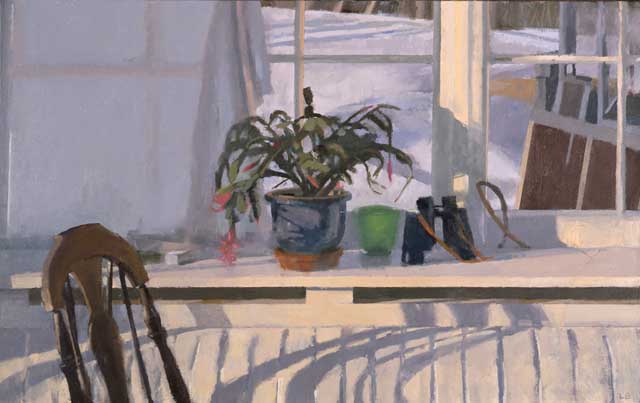
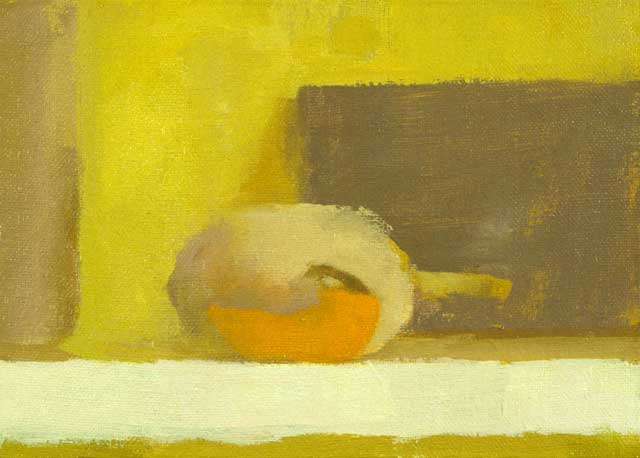
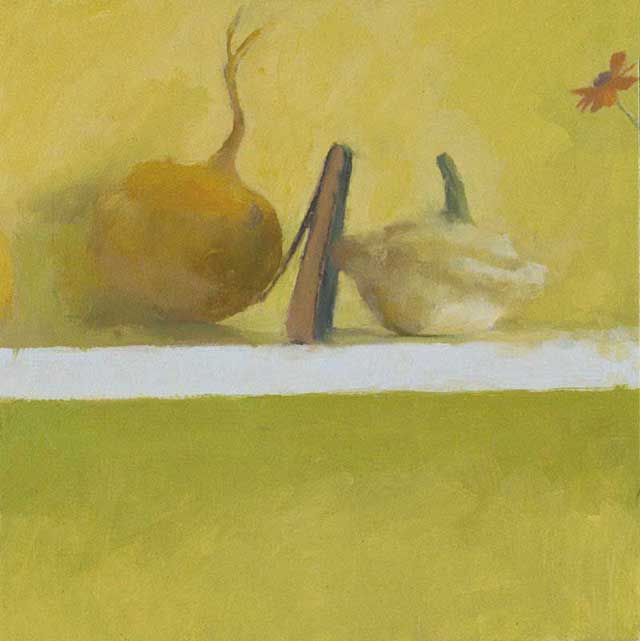
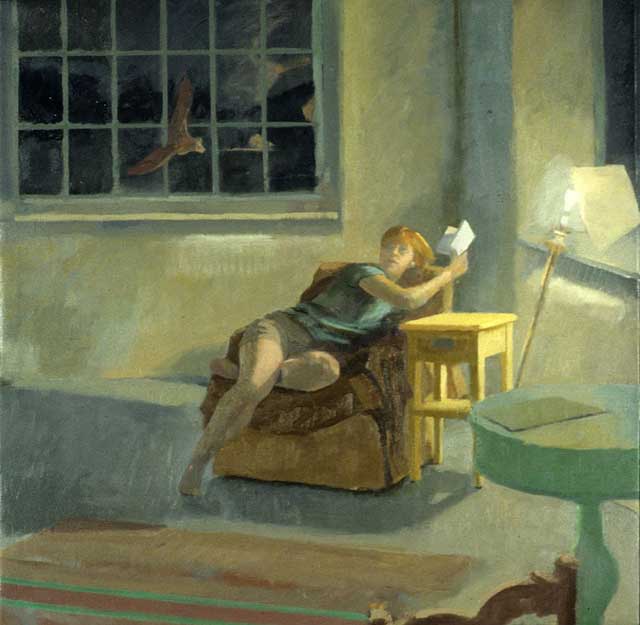




Lucy you are amazing! Seeing your art work is so enjoyable.
These are great paintings, thanks for the introduction.
I wonder if it would be a transgression for someone who hasn’t studied with Lennart to start painting on muslin mounted to panel? Joking.
I love the window still-lives and views. And ‘The Bat’. Is there a Balthus quote or is it just my imagination? The lawnmower not so much for subject and my own bias rather than formal complaint. When the leaf-blowers are screaming there’s no painting for me. Screw those things.
I admire anyone who can use photography so judiciously in the creation of a painting. That’s a difficult line to toe … with urgent,lively non-photorealist works. No doubt success such as Barber’s is a indication of great experience and sensibility.
And speaking of Lennart’s students I wonder if you, Larry, have tried to get a line-out to Peter Colquhoun? I’m pretty enthralled with his work and would love to read about his process. But of course all the good work you do is very much appreciated by this reader and viewer.
Austin, thanks again for your comment, always a pleasure to read. I would agree with you on the Balthus quote – many connections although the model is more age-appropriate and I’m not sure what or who the Bat might represent… As much as I too hate the sound and volume of leafblowers and similar, I love the lawnmower painting for its quirky composition. Thanks for the heads up about Peter Colquhoun’s painting, I wasn’t familiar with his work – very nice. I will put him on my long list of future artists to contact and I will try to ask him something about his process.
thanks for you comment John and everyone else – I’m thrilled that Lucy gave us this interview and agreed to share such terrific paintings with us.
Very nice, reflective interview!
Thank you Larry for this great interview with Lucy. As I see her work I feel so inspired and moved. It touches a deep chord in me.
Leyla
So glad to see this interview. Lucy deserves a lot more attention than she’s received for her considerable artistic gifts. I’ve always taken great pleasure in and had great admiration for her work whether as a photographer, or painter.
wonderful paintings!! thanks for sharing these, Larry!
Larry,
Thanks for posting this. I knew Lucy from Brooklyn College days. She’s a terrific painter. Great to see what she’s up to.
Many wonderful paintings!
Really nice paintings…I also particularly like the ‘lawnmower’ painting. It’s so goofy but ominous at the same time…like, if you don’t get out of my way, I’m going to mow you down. (great shapes in the background, too) Thanks for introducing me to another great painter Larry!
I love Barber’s color and feeling for atmosphere. Her compositions clearly speak of photography and modern painting while visiting classical ideas. Really a fantastic sensibility. Her surfaces and paint must be lovely in person; I wish I could see them in the flesh!
That is a really wonderful interview – I wish it was longer! Thank you both for doing this. I’ve heard Lucy’s name for years but haven’t had a chance to look at her work. It’s really lovely work and am happy to finally see it.
Thanks for the introducing me to Lucy’s work. I found it to be very inspiring and beautiful. Some of the still lifes had the feeling of Albert York’s work, and also Morandi. They definitely had their own sensibility though. As others have said, I wish could see them for real.
Thank you everyone for your comments…@Austin, I didn’t know about painting on muslin until much later after studying with Lennart, though I did learn about it from a fellow BC grad who also studied with Lennart. Besides muslin I’ve painted on silk fabric and silk paper, and that’s pretty amazing. Silk fabric especially is an amazing surface to paint on. This silk paper was too slippery. I once found some very nice pale, dullish yellow-green linen dinner napkins at a Goodwill store and they became the painting support on panels for the kitchen shelf series (the small 5×7 paintings).
The Bat is based on a true event. The Balthus quote wasn’t intentional, but I love his work so much and how the weight of his figures quotes Piero della Francesca. The true event was in late August 2002, when I woke at 2am in the morning, sleepless, and decided to read. It was in a tiny apartment in Brunswick Maine, where I was teaching at Bowdoin. I was renting an apartment in a building that was owned by Joshua Chamberlain, Civil War Hero, and the apartment I was in was part of an apartment rented by Nathaniel Hawthorne.
Shortly after I turned the lights on I heard a rustling and then the bat appeared. I’ll finish the story later. Gotto go!
The encounter with the bat was very unsettling and it took a day and a half to get out of the very small apartment. I became intrigued in bats, so I did some reading & researching. The image of the bat actually came from a a postage stamp.
Thanks for posting the great interview, Larry. I met Lucy at Brooklyn College in the MFA program. Just wanted to say, your work is wonderful, Lucy. So glad to see it!
Sincerely,
Mike
Lucy, I love your work. I’m particularly impressed with Tiber River No. 1–it works for me on so many different levels.
What a wonderful tour of your odyssey into painting. I love Lawnmower – great shadows. And the landscapes …. ahhhhhhhh. Thanks for letting me see these, and your interview.
Lucy,
You have been keeping such a secret. Shame on you. I never knew how talented an artist you are.
Pursue this further. Sarasota needs to know about you!
Lucy,
Nice to see this lovely article about you! Enjoyed seeing your paintings after all this time…
Lucy,
Nice to see this lovely article about you! Enjoyed seeing your paintings after all this time…
These paintings are amazing. What a talent in Sarasota!
Lucy, wonderful, brilliant…. Thank you.